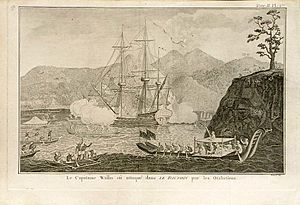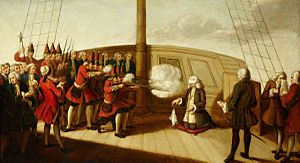Benjamin Marlow facts for kids
Quick facts for kids
Benjamin William Marlow
|
|
|---|---|
| Born | 1715 Salisbury, Wiltshire |
| Died | 1795 Hampstead, London |
| Buried |
Alverstoke, Hampshire
|
| Allegiance | Great Britain |
| Service/ |
Royal Navy |
| Rank | Admiral of the Blue |
| Commands held | HMS Fortune HMS Dolphin HMS Minerva HMS Prince HMS Coventry HMS Rippon |
| Battles/wars |
|
Admiral Benjamin William Marlow (1715-1795) was an important British flag officer in the Royal Navy. He was known for his bravery in battles and for changing how young officers were trained.
Contents
Benjamin William Marlow was born in 1715 in Salisbury, Wiltshire. He came from a noble family. His father, Thomas William Marlow, was also an officer in the Royal Navy.
Marlow likely joined the Royal Navy as a midshipman when he was quite young. A midshipman was a trainee officer. In 1743, he became a Fourth Lieutenant. He was assigned to HMS Grafton, a large warship with 70 guns.
In 1744, Marlow survived a shipwreck on the Grafton. Many crew members and the captain died. Later that year, he was promoted to Third Lieutenant. He served on HMS HMS Assistance, another warship. Soon after, he became First Lieutenant and joined HMS HMS Falmouth.
The Battle of Minorca and Admiral Byng's Trial
In 1756, Marlow was promoted to captain. He took command of HMS Dolphin, a fast warship called a frigate. His ship joined the fleet of Admiral Byng. Soon after, Byng's fleet was sent to Minorca. This island was being taken over by French troops. Only the fort at St. Philip’s Castle was still holding out.
On May 19, Byng's fleet arrived. They found the French already in control of most of the island. Byng had orders to help the fort. But a French fleet of 12 warships and 5 frigates appeared. The two fleets prepared for battle the next morning.
Byng's fleet had 12 large warships. Marlow's Dolphin was in a separate line of smaller ships. During the battle, the main warships fought hard. But Byng was very cautious. He followed standard fighting rules too strictly. This stopped the Dolphin from getting close enough to fire its cannons effectively.
Both sides had damaged ships. After the battle, a meeting was held. Marlow was there. They decided the British fleet could not defeat the French or help the fort. So, Byng ordered his fleet to return to Gibraltar.
The battle was not a clear win for either side. But because the British did not win, it was seen as a defeat. The Admiralty (the Navy's leaders) accused Byng of not doing his best. He was put on court-martial (a military trial). He was found guilty and sentenced to death. Marlow was a witness at the trial. He spoke up for Byng. But despite pleas for mercy, Byng was executed on March 14, 1757.
Battles and Adventures
Even though he was involved in the Battle of Minorca, Marlow was found innocent. He kept his command. In 1757, he helped HMS HMS Hussar sink a French ship called Alcion. He also captured another French ship, the Marquis de Barrail. Marlow was honored by the city of Aberdeen for protecting their coast and trade.
On May 21, 1758, Marlow found a famous French ship, the Belle-Isle. It was commanded by Francois Thurot. Marlow's HMS Dolphin and HMS Solebay went after it. The Belle-Isle was much more powerful. Marlow fought alone for about 90 minutes. His ship was badly damaged. When Solebay arrived, Marlow could not help much. Both sides suffered many injuries. In the end, Thurot could not force the British ships to surrender. The battle ended with both sides sailing away.
Marlow asked for a court-martial to review his actions. He wondered if he could have done more. But the court honorably cleared him of any blame.
After this battle, Marlow helped protect trade ships going to North America. During this time, he met a young Horatio Nelson. Nelson became very sick with malaria. He sailed back to England on Marlow's ship. Nelson spent six months recovering during the voyage.
Marlow later commanded HMS Prince, a large 90-gun warship. Then he took HMS Coventry to the East Indies. He stayed there for seven years. He was part of a battle against the French near Pondicherry.
Marlow was then promoted to flag captain. He served under Commodore Sir Edward Vernon on the Rippon. When he returned home in March 1781, he learned he had been promoted to rear-admiral.
Later Life and Legacy
Marlow had an amazing career. He did not see any more battles after his return. He stayed with the Grand Fleet in Portsmouth. He was promoted to vice-admiral in 1787. Then he became a full admiral in 1794. He died in Hampstead in 1795. He was buried in Alverstoke, Hampshire. A memorial was put up for him in Salisbury Cathedral.
Marlow was married to Lydia Hamond. They had several children. His first son, also named William Marlow, became an important military figure too.
Marlow is remembered for his excellent service. He also had new ideas about leadership and training. He was one of the first to suggest training young officers together in groups. This way, they could learn math, navigation, and sailing skills more easily. Before this, midshipmen were expected to learn everything on the job.
Marlow often took groups of midshipmen on his ships. He made sure they spent time every day learning these important skills. It is believed that Nelson benefited from this approach while serving with Marlow on HMS Dolphin. Because of this, Marlow is seen as the person who started the system of the British Naval College. This is how the Royal Navy still trains its young officers today. This training model has spread around the world.
The Royal Navy still supports the Marlow Society. This group works to keep his goals and ideas alive.
Images for kids







